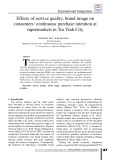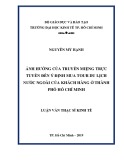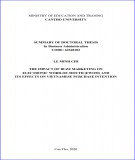
TẠP CHÍ KHOA HỌC KINH TẾ - SỐ 12(01) 2025
99
EXPLORING THE IMPACT OF CELEBRITY BRAGGING TYPES ON
CONSUMER PURCHASE INTENTIONS: UNVEILING THE ROLES OF
SELF-PRESENTATION AND SELF-CONGRUITY
KHÁM PHÁ TÁC ĐỘNG CỦA CÁC KIỂU KHOE KHOANG CỦA NGƯỜI NỔI TIẾNG
ĐẾN Ý ĐỊNH MUA HÀNG CỦA NGƯỜI TIÊU DÙNG: VAI TRÒ CỦA YẾU TỐ
THỂ HIỆN BẢN THÂN VÀ PHÙ HỢP BẢN THÂN
Ngày nhận bài: 25/05/2024
Ngày nhận bản sửa: 24/10/2024
Ngày chấp nhận đăng: 12/12/2024
Pham Thi Be Loan
, Dang Quang Vinh, Nguyen Minh Anh Trang, Nguyen Kim Phuong,
Tran Thi Hieu
ABSTRACT
As the internet celebrity economy thrives, companies prioritize celebrity endorsements. Celebrities
often boast about luxurious lifestyles on social media, showcasing exclusive vacations and luxury
products, yet scientific knowledge on how such bragging influences purchase intentions remains
limited. This study examines the effects of celebrity bragging and humblebragging on purchase
intention regarding luxury foreign products. The samples would be gathered using the convenience
sampling technique, with the data gathered through online questionnaires shared in social media
accounts, with respondents up to 296 people. The analysis method that would be implemented
was the Structural Equation Modeling (SEM), using the SmartPLS 4.0 software. The results reveal
the following: (1) Bragging negatively impacts purchase intention, while humblebragging has a
positive effect. (2) Furthermore, the influence of bragging types on purchase intention is mediated
by consumer self-presentation and self-congruity. Both bragging types enhance willingness to
purchase through self-presentation; while bragging negatively and humblebragging positively affect
purchase intention through the mediation of self-congruity. The study offers new insights into
consumer behavior towards luxury products, presenting a fresh viewpoint on how individuals
perceive and interact with celebrity content on social media. Our findings expand and deepen the
existing literature on bragging on social media, thus, providing valuable practical implications for
businesses to either utilize or avoid bragging and humblebragging in their marketing efforts.
Keywords: Bragging, humblebragging, self-presentation, self-congruity, purchase intention.
TÓM TẮT
Khi nền kinh tế của các người nổi tiếng trên Internet phát triển mạnh mẽ, các công ty đang ưu tiên
cho việc ủng hộ của người nổi tiếng. Những người nổi tiếng thường tự hào về cuộc sống xa hoa
trên mạng xã hội, những kỳ nghỉ độc quyền và sản phẩm xa xỉ, tuy nhiên kiến thức khoa học về
cách khoe khoang này ảnh hưởng đến ý định mua hàng vẫn còn hạn chế. Nghiên cứu này điều tra
các tác động của việc khoe khoang thẳng thắn và khoe khoang khiêm tốn của người nổi tiếng đối
với ý định mua hàng liên quan đến các sản phẩm xa xỉ nước ngoài. Mẫu sẽ được thu thập bằng kỹ
thuật lấy mẫu thuận tiện, với dữ liệu được thu thập thông qua bảng câu hỏi trực tuyến được chia
sẻ trên các tài khoản mạng xã hội, với số người trả lời là 296 người. Phương pháp phân tích sẽ
được triển khai là Mô hình phương trình cấu trúc (SEM), sử dụng phần mềm SmartPLS 4.0. Kết
quả cho thấy: (1) Việc khoe khoang thẳng thắn ảnh hưởng tiêu cực đến ý định mua hàng, trong
khi khoe khoang khiêm tốn có tác động tích cực. (2) Hơn nữa, sự ảnh hưởng của các loại khoe
khoang đối với ý định mua hàng được trung gian qua sự tự thể hiện bản thân và sự tự phù hợp
với bản thân của khách hàng. Cả hai kiểu khoe khoang đều thúc đẩy ý định mua hàng thông qua
sự tự thể hiện bản thân; trong khi khoe khoang thắng thắn tác động tiêu cực thì khoe khoang
khiêm tốn lại ảnh hưởng tích cực đến ý định mua hàng dưới sự điều tiết của sự tự phù hợp bản
thân. Nghiên cứu mang đến những hiểu biết mới về hành vi tiêu dùng đối với các sản phẩm xa xỉ,

















